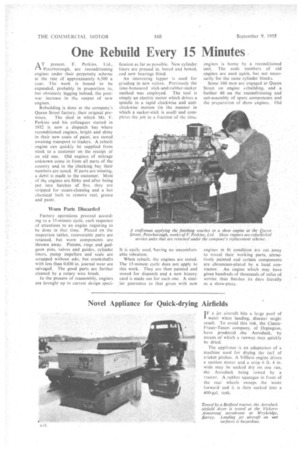One Rebuild Every 15 Minutes
Page 52

If you've noticed an error in this article please click here to report it so we can fix it.
ATpresent, F. Perkins. Ltd., Peterborough, are reconditioning engines under their perpetuity scheme at the rate of approximately 6,500 a year. The work is bound to be expanded, probably in proportion to, but obviously lagging behind, the postwar increase in the output of new engines.
Rebuilding is done at the company's Queen Street factory, their original pre
mises. The shed in which Mr. F. Perkins and his colleagues started in 1932 is now a dispatch bay where reconditioned engines, bright and shiny in their new coats of paint, are stored awaiting transport to traders. A rebuilt engine. can .quickly be supplied from stock to a customer on the receipt of an old one. Old engines of mileage unknown come in from all parts of the country and in the 'checking bay their numbers arc noted, If parts are missing, a debit is made to the customer. Most of the engines are filthy and after tieing put into batches of five, they are stripped for steam-cleaning and a hot chemical bath to remove rust, grease and paint.
Worn Parts Discarded Factory operations proceed according to a 15-minute cycle, each sequence of attentions to an engine requiring to be done in that time. Placed On the inspection tables, recoverable parts are retained, but worn components are thrown away. Pistons, rings and gudgeon pins, valves and guides. cylinder liners, pump impellers and seals are scrapped without ado, but crankshafts with less than 0.030 in. journal wear are salvaged. The good parts are further cleaned by a rotary wire brush.
In the process of reassembly, engines are brought up to current design speci. fication as far as possible. New cylinder liners are pressed in, bored and honed, and new bearings fitted.
An interesting lapper is used• for grinding in new valves, Previously the time-honoured stick-and-rubber-sucker method was employed. The tool is simply an electric motor which drives a spindle in a rapid clockwise and anticlockwise motion (in the manner in which a sucker-stick it used and completes the job its a fraction of the time.
It is easily used, -having no uncomfortable vibration.
When rebuilt, the engines are tested. The 15-minute cycle does not apply to this work. They are then painted and stored for dispatch and a new history card is made out for each one. A similar guarantee to that given . with new engines is borne by a reconditioned unit. The code numbers of old engines arc used again, but not necessarily for the same cylinder blocks.
Some 160 men are engaged at Queen Street on engine 2building, and . a further 40 on the reconditioning and sub-assembly of spare components and the preparation of s-how engines. Old
engines in tit condition are cut away to reveal their working parts, attractively painted and certain components are chromium-plated by a focal contractor. An engine which may have given hundreds of thousands of miles of service thus finishes its days literally as. a show-piece.




























































































